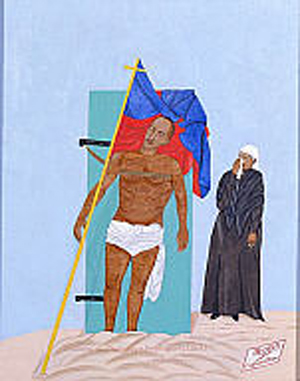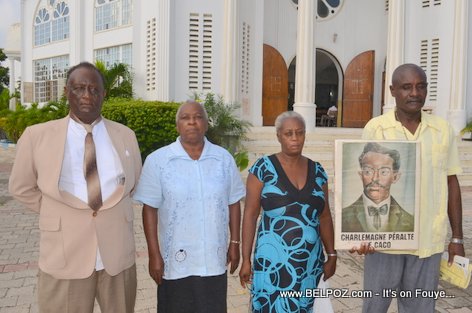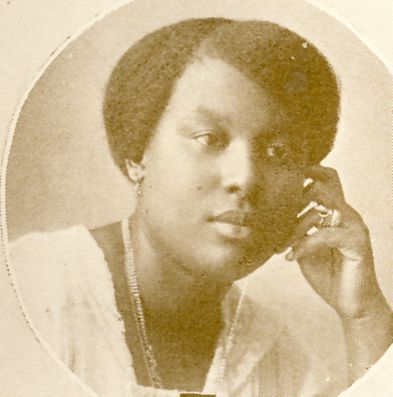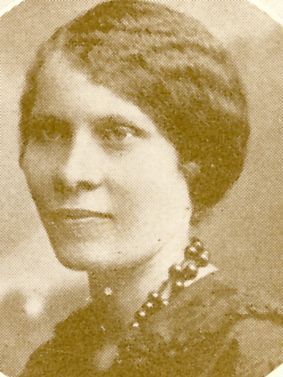You are using an out of date browser. It may not display this or other websites correctly.
You should upgrade or use an alternative browser.
You should upgrade or use an alternative browser.
The Official Early(pre-1950s) Haitian History Thread
- Thread starter Bawon Samedi
- Start date
More options
Who Replied?marleyg
drug
http://www.iacenter.org/haiti/embargoes.htm
He tried hard to prevent any contact between the United States and Haiti. Jefferson called upon Congress, which his party controlled, to abolish trade between the two countries. France and Spain, two major colonial powers in the Caribbean at the time, were also enforcing boycotts of Haitian trade. Consequently, partially in 1805 and finally in 1806, trade between the United States and Haiti was formally shut down.
He tried hard to prevent any contact between the United States and Haiti. Jefferson called upon Congress, which his party controlled, to abolish trade between the two countries. France and Spain, two major colonial powers in the Caribbean at the time, were also enforcing boycotts of Haitian trade. Consequently, partially in 1805 and finally in 1806, trade between the United States and Haiti was formally shut down.
loyola llothta
☭☭☭

When it comes to legendary Haitian singers, very few singers are in the rank of Martha Jean-Claude. Born on March 21, 1919 in Port-au-Prince, Haiti, Martha’s golden voice was as memorable as her career, which Haitian musical historians say begun in the late 1930s and early 40s, with young Martha singing at musical spectacles at Haiti’s famed Rex Theatre and at other informal gatherings.
Martha, who became known for her skills atcreating original compositions, was an astute writer as well, penning a play entitled “Avrinette”in 1952 that Haitian President Paul Eugene Magloire found so disrespectful to his government that he had her imprisoned. Jean-Claude would later state that she gave birth to her child two days after her release. It became clear to her that Haiti would not be a safe place to remain, and she left it for Cuba, where her husband Victor Marabal (spelled Marabel insome sources).
She married the Cuban journalist though some scholars do not seem to agree on when. Some say, it was prior to her forced exile to Cuba in 1952, others say it was in 1947, prior to her exile (they reportedly had met in Venezuela). What she has said in interviews, however, was that when she went into exile, she was pregnant with her first child and refers to Marabal as her husband. So naturally, we’ll go with her version.
Her exile to Cuba would last for nearly three consecutive decades, as she did not return to Haiti until February 1986, when Jean-Claude Duvalier left Haiti for exile in France. That year, Jean-Claude had one of the most awaited concerts of her career, as she performed a comeback concerts in front of thousands in Port-au-Prince. She wouldn’t perform at a concert of this magnitude for another ten years, during which she accompanied Celia Cruz and Emerante de Pradines for a spectacular show. Over the years, she and Cruz had performed together and even recorded music together.
Jean-Claude actually traveled a great deal around the world, including Puerto Rico, Angola, Montreal, and Mexico where she spent a year performing in the late 1950s. Among the most famous songs in her repertoire was “Jack Solèy”, a tribute to Jacques Stephen Alexis, a writer who disappeared without a trace, and presumably was murdered in 1961. Others included “Tolalito”, a frolicking folk song that made the best of Jean-Claude’s throaty voice. In 1993, she lent her voice to the soundtrack of Raoul Peck’s film L’Homme Sur Les Quais. That year, she also released the LP Soy mujer de dos islas.
For her musical accomplishments that started with her recording of the albumCanciones de Haiti, and for her work as fearless activist, Jean-Claude was presented with Haiti’s highest honor by Haiti’s then-president Rene Preval in the 1990s.
Click to read more
loyola llothta
☭☭☭
Bruh its a haitian history threadEx-North Miami mayor gets 65 months for role in fraud scheme
By Lance Dixon

Former North Miami Mayor Lucie Tondreau talks with the media outside the United States Federal Courthouse in downtown Miami last May. CHARLES TRAINOR JR MIAMI HERALD FILE
Lucie Tondreau, a community activist who made political history as North Miami’s first female Haitian-American mayor, was sentenced to 65 months in federal prison on Tuesday for her role in an $11 million mortgage fraud scam.
A tearful Tondreau said she wished “she could turn back time” and apologized to people she hurt — especially to the community who saw her as a symbol of hope and helped elect her mayor.
“I wish I understood the implications of what I was doing,” Tondreau told U.S. District Judge Robert Scola during her sentencing hearing.
A Miami federal jury found her guilty of conspiracy and wire-fraud charges after a two-week trial in December featuring emotional testimony from individuals who acted as “straw buyers” and said they had trusted her.
Tondreau, 55, had faced a potential sentence of up to 30 years but Scola said he recognized that Tondreau had learned a lesson. Still, the judge said, a strong message needed to be sent to anyone else considering mortgage fraud operations and similar schemes.
“The mortgage fraud caused great damage not only to the banks but to the people who were brought in, the straw buyers whose credit was ruined,” Scola said.
Tondreau’s defense attorneys highlighted her good works as a community activist, calling several witnesses who spoke highly of her. They said she never asked for money when she gave them assistance.
“She is someone who seems to be from the people, who knows the people,” Emmanuel Alvarez, a Haitian radio host, said. “Money could never be the motivation for the Lucie Tondreau I’ve known for the last 30 years.”
The defense also submitted several letters of support from community members along with elected officials like Miami-Dade County Commissioner Audrey Edmonson, U.S. Rep Frederica Wilson, D-Miami Gardens, and former Miami Mayor Maurice Ferré.
Prosecutors held firm to their argument that Tondreau was not unwittingly tricked into the scheme by her co-defendant, former business partner and ex-fiance, Karl Oreste. U.S. Attorney Lois Foster-Steers argued that the plan wouldn’t have worked without Tondreau.
“People trusted her and without the straw buyers, without the individuals with names, identities and credit, this fraud would not have been successful,” Foster-Steers said.
Throughout the hearing, muffled whimpers and tears were heard from supporters in the audience, especially as Tondreau was taken away in handcuffs after Scola’s decision. One woman nearly fell off her bench in tears but was quickly consoled by others around her. Tondreau’s attorneys considered the sentencing a slight victory, given the 30 years she might have faced.
“We asked for a lower sentence, but the government asked for a significantly higher sentence and the judge did what he was thought was appropriate,” attorney Ben Kuehne said. “We have no grievance with that.”
Kuehne said he and Tondreau’s other defense attorney, Michael Davis will appeal the decision.
The government found that she and her co-defendants, including Oreste and two other men who are fugitives, tricked banks into loaning them $11 million between 2005 and 2008 in the midst of the real estate boom.
Oreste, 57, pleaded guilty to wire-fraud conspiracy last July and in his plea agreement said he and Tondreau used Haitian radio to draw people into their scam against eight banks, including large ones like Wachovia. Oreste, in his statement, said they used the money to purchase more than 20 homes and pocket personal cash.
He was sentenced to more than eight years in prison last month.
A group of eight straw buyers testified during the trial and said they received thousands of dollars for participating in the scheme, but many said their credit and finances were significantly damaged.
Before her brief political career, Tondreau was widely known in the Haitian community for voicing her opinions on Haitian radio over the years. Before her trial began last December she continued to make appearances on the TV show Face a Face on Island TV, a Haitian-American cable network.
Former North Miami councilman Jacques Despinosse said he thinks the situation will bring healing to the community and he’s happy that she didn’t get the maximum sentence.
“We knew the judge was not just going to let her go, but five years is better than 30 years,” Despinosse said.
He and other supporters mostly expressed concern for Tondreau’s daughters—Nancy Lafleur, Elodie Alcindor and 15-year-old Luddy Delmont. Outside of the federal courthouse Tuesday, Lafleur said she was thankful for the final outcome.
“We’re still praying, we’re still together, we’re still a community because that’s what she stood for,” Lafleur said.
Tondreau was also sentenced to three years of supervised release at the conclusion of her prison term. The restitution she’ll have to pay will be finalized by the end of May.
Read more here: http://www.miamiherald.com/news/loc...orth-miami/article16122632.html#storylink=cpy
Bruh its a haitian history thread
this is history, she was born in Haiti. i met her in 2008. posted a thread on her when the c*cs started messing with her.
About Me

Lucie cares about the city of North Miami
“One of the Most Active Community Leaders in the Haitian-American Community”, “Political Dynamo”, and holder of the “Claire-Heureuse Award” , Lucie Tondreau has been a tireless advocate in our local community for her fellow citizens and residents for the past 28 years.
Born in Haiti, Lucie’s family fled the brutal and repressive totalitarian regime of Duvalier’s family in 1967 after her father spent six months in the famous Fort-Dimanche’s death cells. After her father was released from this dreaded jail, Lucie’s family began their long exile journey to Montreal when Lucie was a 7 years old girl. When Lucie reached adulthood in 1981, she went on a lifetime journey to find her family roots which led Lucie to travel to the Ivory Coast, Senegal, Jamaica, Trinidad & Tobago, and Barbados.
In 1982, Lucie began her work as an advocate for the Haitian-American community as a journalist. During her two years in New York City, Lucie hosted the first Haitian-American Radio program called “Moman Kreyol” as well as the first Haitian-American Television show known as “Haitian Top Ten”. In addition, Lucie was a contributor to the popular “Haiti Progres” newspaper for NYC’s Haitian-American community.
After two years in New York City, Lucie made the life changing decision to settle in South Florida. As she witnessed the day-to-day struggle faced by many Haitian immigrants arriving on U.S. shores, Lucie became engaged as an activist and joined community organizations in Miami’s Haitian diaspora community including the Haitian Refugee Center led by Father Gerard Jean-Juste and the Haitian American Community Association of Dade (HACAD).
At the Haitian Refugee Center, Lucie worked side by side with Father Gerard Jean-Juste. Lucie volunteered long hours as an unpaid instructor for teaching basic literacy courses and has traveled frequently to Haiti to report on various important events and as a co-host the popular, live radio show called “Guinen diziem” with Father Gerard Jean-Juste.
In November 1987, Lucie witnessed the brutal assassination of countless numbers of Haitians by the fierce Duvalier dictatorship at polling stations throughout Haiti. Two years later, Lucie returned to Haiti to cover the election of Jean-Bertrand Aristide.
In 1991, Lucie began to mobilize our local Haitian-American community into action so that it could participate as a partner in the political process in Miami-Dade County. Lucie became a voters’ rights advocate and partnered her involvement with the African-American community by joining as a member of NAACP, the Haitian-American Grassroots Coalition, and other community based organizations.
A tireless advocate, Lucie has continued to fight for human rights on behalf of those Haitian immigrants who were subjected to cruel treatment by the officials of the Krome Detention Center.
In her first bid for political office in 2002, Lucie came close to unseating a powerful Miami-Dade County Commissioner with a grassroots campaign with a fraction of the powerful incumbent’s funds. Lucie’s candidacy for county commissioner earned the endorsement of many prestigious organizations and businesses including the Women’s Caucus, Police Benevolent Association, El Herald, and the Miami Herald. With the combination of El Herald and the Miami Herald’s endorsements, their editorial board made this bold statement about Lucie’s candidacy: “her depth of how county government works … that is unusual in first time candidates.”
Lucie has been invited to speak on human right issues and struggles of the Haitian community at The University of West Indies in Mona, Jamaica; Harvard University in Boston, Massachusetts; and The University of South Africa in Pretoria, Africa.
After the October 2005 violent destruction of Hurricane Wilma in Miami, Lucie diligently organized a grass root group of volunteers to help assist the less fortunate Haitian-American community deal with extensive and widespread damage. Her leadership provided the daily distribution of 500 food plates to the elderly, the disabled, pregnant women, and people with metabolic syndrome.
Once again, Lucie was called into action after the another natural disaster when the catastrophic earthquake hit Haiti on January 12, 2010 left Haiti with total widespread destruction and death experienced in her native birth country, Lucie sprang into action by advising and undocumented Haitian refugees seeking help in filing and obtaining temporary work visas for survival.
Since September 1999, Lucie has been the owner and chief operating officer of Tondreau & Associates, a consulting firm for immigration and public relation issue, located in North Miami. Lucie anchors the weekly program “Face to Face on Island TV and co-hosts a daily Haitian-American Creole Radio Show “L’ouvri Je”.
Lucie has been a board member of the following community-based organizations:
Florida Commission on the Status of Women
Haitian-American Grassroots Coalition which includes 16 Haitian-American organizations
Veye-Yo
Arts in Public Places
Aspira
Kidco
Haitian Political Action Committee
The Citizen Independent Transportation Committee
Caribbean Pan African Network
City of North Miami’s Charter Review Board
CRA advisory Board
City of North Miami’s Adjustments board
City of North Miami’s Parks and Recreation
City of North Miami’s Attorney Selection Committee
Lucie is the mother of three children: Nancy, Elodie, and Luddy as her family lives on the Sunkist Grove neighborhood in North Miami.
loyola llothta
☭☭☭
loyola llothta
☭☭☭

Haitians in Montreal, Quebec, Canada. Circa 1960s. Image Courtesy of: CIDIHCA Collections.
During the period of the dual Duvalier dictatorships (1957-1986), and especially following the repressions of 1964, many middle-class Haitians chose to relocate to Canada. Most settled in Quebec given its position as Canada’s predominantly French-speaking province. As they arrived during Quebec’s Quiet Revolution, they became an integral part of the province’s changing social and political dynamics.
loyola llothta
☭☭☭

Paul Robeson and Ruby Elzy in the 1933 film adaptation of The Emperor Jones (based on Eugene O’Neill play by the same name)
Haiti and Images of Black Nationhood
"The work of art that perhaps galvanised the Harlem Renaissance’s fascination with black nationhood (and black leadership) was Eugene O’Neill’s 1920 play, The Emperor Jones. A thinly veiled drama about the failures of Henri Christophe’s despotic reign over the island of Haiti, The Emperor Jones was an important vehicle not only for actors like Charles Gilpin and Paul Robeson, but also for visual artists as well (Aaron Douglas’s blockprint illustrations for the play in 1926 and Dudley Murphy’s film treatment of the play in 1933). Although The Emperor Jonespresented the idea of black nationhood and leadership in a negative, racially atavistic light (no doubt with Marcus Garvey’s ‘Africa for Africans’ rhetoric and his failed attempts at nation building in mind), its focus on black agency and independence was not lost on Harlem Renaissance audiences.”
"The history propaganda and mystique that surrounded Haiti - beginning with the US military invasion and occupation of the island in 1915 - took on a life of its own during the Harlem Renaissance. In addition to The Emperor Jones, scores of novels, plays, ethnographic studies and journalistic exposés used Haiti and its peoples for a range of purposes. While Haiti’s tortured political history and its cultural links to certain African traditions were viewed by many commentators as evidence of its geo-political weakness and savagery, these same attributes wee viewed by others as reasons for recognising the political power among all peoples of African descent and celebrating Africa’s gifts (via Haiti) to world culture. With the removal of the US Marines from Haiti in 1934, this fascination with the island and its mythologies manifested itself in interesting ways, from Josephine Baker’s staged musical portrayal of a caged Haitian songbird in the 1934 film Zou Zou, to two major off Broadway plays dealing with black political intrigue, Haitian style: John Houseman’s and Orson Welles’s Black Macbeth (1936) and William DuBois’s Haiti (1938)."
Read full piece at the Institute of International Visual Arts
loyola llothta
☭☭☭

Charlemagne Péralte
Charlemagne Peralte was born in 1886 in the town of Hinche, Péralte was an officer in the Haitian Army. He resigned in 1915 and returned to his home in Hinche to become a farmer. When the US Marines, who had invaded Haiti in 1915, began forcing Haitians into labour gangs to carry out public works, antipathy to the US occupation grew.In 1917 Péralte was arrested for an attack on the home of a US officer, and sentenced to five years hard labour. He escaped from captivity, and mobilized several thousand peasant irregulars to fight against the US occupation. This band of peasants called ” Cacos” wreaked havoc in the countryside for the better part of two years. The success of the guerrilla resistance campaign led by Péralte, forced the US to deploy more Marines, but he was still able to declare a provisional government in the north of Haiti in 1919.
In November 1919, Péralte was betrayed by one of his troops, Jean Baptiste Conzé, who led a small contingent of disguised marines including second lieutenant Herman Hanneker to Peralte’s hard-to-find camp. Peralte was killed in the short fight that followed. The US Marines took his body to the town of Hinche and attached it to a door in a Christ-like fashion in order to discourage further rebellion. A famous photograph, and also a painting by renowned artist Philome Obin have immortalized that image which has taken its place as an icon of Haitian nationalism. Peralte’s lieutenant, Batraville continued the fight, but it never regained the impetus it had under Charlemagne.

Charlemagne's mother Me. Anne Marie Péralte

His brother Sevigne Péralte



This photo of Charlemagne Peralte’s corpse tied to a door and with the Haitian flag around its head was dropped throughout Haiti on November 1, 1919

Crucifixion de Charlemagne Péralte pour la Liberté (by Philome Obin).


Family Members of leader Charlemagne Peralte gather to commemorate his death, 31 October 2014, at the Cathedral de Hinche.
loyola llothta
☭☭☭
Mr.Big Meat McGee
All Star
If Haiti had lost the Revolution, the French would've never sold it's land to America. America most likely would've gone to war with France for the land and would've lost.
Mr.Big Meat McGee
All Star
To add they built the Citadelle because it overlooks Cap-Haitian and they could fire long range canons from there. Funny how when you are in the Cap Haitien port you can barely see the fortress, but when you're up there it loioks so close. Christophe was a damn genius. Too bad, he became a psychopath and was killing his own. His beef and exchange with PetionSo many quotables and chess moves.
Btw, that Muslim shyt is bullshyt. STraight up. Muslims trynna invade Haiti but they were always made fun of which is why they went to Trinidad and Ghana. Muslims have never been popular in Haiti, and they never will be
Muslims soft af

loyola llothta
☭☭☭

Yoruba woman lot of Yorubas in New Orleans Brazil and Haiti
Most “Yoruba” proper in Haiti and Brazil now are relatively new migrants. Many Haitians and Brazilians share ancestry with Yoruba people through the Nago, Ewe, Fon, and Gen people of what are now Nigeria and Benin. A lot of us hail from the old Dahomey Kingdom, coming to this hemisphere through the kingdom/city-state (and major slave trading post) of Whydah/Hueda/Ajuda/Xwéda, where it is believed we get the “Wedo” in Danballah and Ayida Wedo. This is a good documentary to learn more, but it is but one source.
Mr.Big Meat McGee
All Star
*Not My Words*
As we know from the pronouncements of Boukman Dutty and Cecile Fatiman, the Hatian Revolution was first inspired by a Vodoun ceremony in which practictionars stated:
Hidden God in a cloud
Is there, watching us.
He sees all the whites do;
The Whitegod demands crimes
Ours wants good things.
But our God that is so good
Orders vengeance, he will
Ride us, assist us.
Throw away the thoughts of
The Whitegod who thirsts
For our tears, listen to
Freedom that speaks to our hearts
This speech and ceremony was the precursor to the revolution. And we know from history, that any sort of Spiritual tradition that was not Christianity was a damned tradition and therefore so where the people.
As we know from the pronouncements of Boukman Dutty and Cecile Fatiman, the Hatian Revolution was first inspired by a Vodoun ceremony in which practictionars stated:
Hidden God in a cloud
Is there, watching us.
He sees all the whites do;
The Whitegod demands crimes
Ours wants good things.
But our God that is so good
Orders vengeance, he will
Ride us, assist us.
Throw away the thoughts of
The Whitegod who thirsts
For our tears, listen to
Freedom that speaks to our hearts
This speech and ceremony was the precursor to the revolution. And we know from history, that any sort of Spiritual tradition that was not Christianity was a damned tradition and therefore so where the people.








